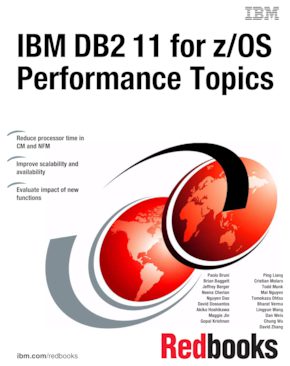
Published on 25 July 2014, updated 11 August 2014
Order hardcopy
Share this page:
ISBN-10: 0738439673
ISBN-13: 9780738439679
IBM Form #: SG24-8222-00
Authors: Paolo Bruni, Brian Baggett, Jeffrey Berger, Neena Cherian, Nguyen Dao, David Dossantos, Akiko Hoshikawa, Maggie Jin, Gopal Krishnan, Ping Liang, Cristian Molaro, Todd Munk, Mai Nguyen, Tomokazu Ohtsu, Bharat Verma, Lingyun Wang, Dan Weis, Chung Wu and David Zhang
Abstract
IBM® DB2® 10 for z/OS® provided a strong performance improvement that drove great value for IBM clients. DB2 11 for z/OS continues the trend by focusing on further CPU savings and performance improvement through innovations within DB2 and the synergy with IBM System z® hardware and software. Most of CPU reductions are built in directly to DB2, requiring no application changes. Enhancements often take effect after the REBIND in the case of static applications, while some enhancements require user actions such as Data Definition Language (DDL) updates.
DB2 11 CPU reduction can potentially provide significant total cost of ownership savings depending on the application mixture and type of transactions.
In this IBM Redbooks® publication we provide the details of the performance of DB2 11 for z/OS discussing the possible performance impacts of the most important functions when migrating from DB2 10. We include performance measurements made in the Silicon Valley Laboratory and provide considerations and high-level estimates. Keep in mind that results are likely to vary because the conditions and work will differ.
In this book, we assume that you are somewhat familiar with DB2 11 for z/OS. See DB2 11 Technical Overview, SG24-8180, for an introduction to the new functions.
Table of Contents
Chapter 1. Introduction
Chapter 2. Subsystem
Chapter 3. Synergy with z platform
Chapter 4. Availability
Chapter 5. IBM DB2 Analytics Accelerator
Chapter 6. Data sharing
Chapter 7. SQL
Chapter 8. Application enablement
Chapter 9. Distributed environment
Chapter 10. Utilities
Chapter 11. Installation and migration
Chapter 12. Monitoring
Appendix A. Recent maintenance
Appendix B. The IBM DB2 workloads
Appendix C. To REBIND or not to REBIND